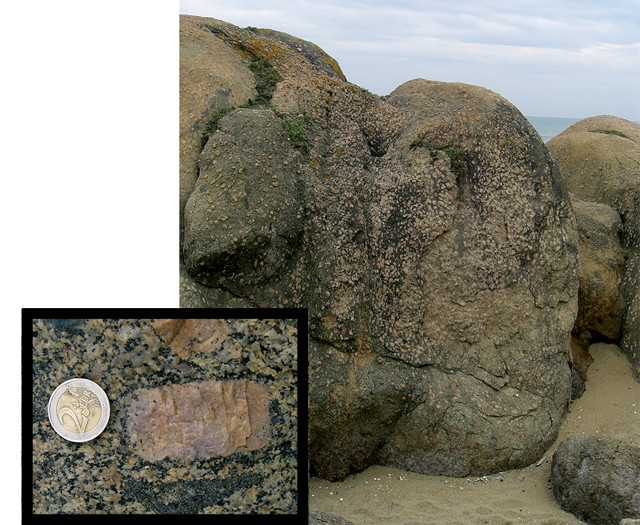
by U.S. Geological Survey Thursday, June 14, 2018
Arnold O. Tanner, mineral commodity specialist for the U.S. Geological Survey, compiled the following information on feldspar, one of the most abundant and widespread rock-forming mineral groups on Earth.

Feldspar in granite on a beach in Portugal. Credit: Both: ©Chmee2, Creative Commons Attribution-ShareAlike 3.0 Unported
Feldspar is the general name of members of a group of closely related anhydrous minerals distinguished by the presence of aluminum and silica in combination with varying proportions of one or more base elements, including potassium, sodium and calcium. The particular mineral is named after its major base element: potassium feldspar, sodium feldspar or calcium feldspar. Feldspars are major components of most igneous rocks and constitute a large part of at least the outer layers of Earth and the moon. By some estimates, feldspar constitutes 60 percent of Earth’s crust.
Feldspar, usually of the potassium or sodium type or mixtures of the two, is principally used in the manufacture of glass and ceramics. In both applications it acts as a flux. Feldspar’s alkali content lowers the melting temperature of the mixture, prompting faster melting and fuel savings. Fluxes melt in early stages of the ceramic firing process, forming a glassy matrix that bonds the other components of the system together. In glassmaking, the mineral’s alumina content enhances the workability of the product and improves product hardness, durability, thermal endurance and resistance to chemical corrosion. Feldspar also serves as a binder and filler in paints and in various abrasive applications. In 2010 in the U.S., some 70 percent of feldspar was used for glass.
Feldspar mining in North America may have begun in pre-Colonial times. Examination of shards from a large number of prehistoric culture centers, widely distributed in both place and time, shows that native potters often depended on feldspar from feldspathic sands to provide the temper (increased hardening) for their clay pots. A small quantity of the mineral, reputedly obtained from Native Americans, is said to have been shipped to Europe in 1744 from somewhere in the mountainous part of what is now North Carolina, the same area that two centuries later would become the primary focus of the U.S. feldspar industry.
Economic resources of feldspar greatly increased in 1940 with the development of successful froth flotation methods for the separation of feldspar. Prior to this, the industry was dependent on more costly hand-cobbing procedures, generally with a handheld hammer, involving the separation of feldspar from worthless or otherwise undesirable minerals.
For more information on feldspar and other mineral resources, visit http://minerals.usgs.gov/minerals/.
U.S. Oil & Petroleum Imports (millions of barrels per day)
Oil and petroleum imports data are preliminary numbers taken from the American Petroleum Institute’s Monthly Statistical Report. For more information visit www.api.org.
Feldspar production and consumption:
In 2010, U.S. estimated feldspar production was 570,000 metric tons valued at about $36 million. North Carolina, Virginia and California produced 89 percent of this feldspar. Georgia, Idaho, Oklahoma and South Dakota made up the remainder.
World mine production of feldspar was an estimated 20 million metric tons in 2010. Three countries — Italy, Turkey and China — produced 55 percent of the world’s feldspar.
Fun facts:
The name feldspar was derived from the German “feldt,” or field, and “spath,” or spar, meaning a common cleavable rock containing no valuable ore that was dredged up as farmlands were plowed.
Apollo 15’s noteworthy 4-billion-year-old lunar sample 15415, called “Genesis Rock” by the astronauts, is about 98 percent calcium-rich plagioclase feldspar.
For every metric ton of glass that is recycled, about 75 kilograms of feldspar are among the more than 1 metric ton of natural resources that are saved in the making of glass.
Over a wide range of temperatures, feldspar remains a solid — in part defined as having crystalline structure at room temperature and a definitive melting point. Glass, the primary end use for feldspar, has neither characteristic.
© 2008-2021. All rights reserved. Any copying, redistribution or retransmission of any of the contents of this service without the expressed written permission of the American Geosciences Institute is expressly prohibited. Click here for all copyright requests.